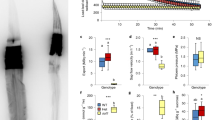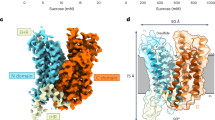Abstract
In contrast to hexoses (fructose, glucose, 3-oxymethylglucose) sucrose is preferentially taken up by isolated conducting tissue ofCyclamen persicum Mill. Sucrose absorption follows a biphasic kinetic, with a saturable component (Km=5.2 mM; Vmax = 4.2 μmol · g FW-1 · h-1) in the lower range (<20 mM) and a linear component in the upper range (20–400 mM). The saturable, carrier-mediated uptake operates against the concentration gradient without attaining any equilibrium over 6 h. It is characterized by a pH optimum at 4.5 and sensitivity to the protonophore CCCP (carbonylcyanidem-chlorophenylhydrazone). The activity of the saturable uptake increases with decreasing turgor and it is independent of the presence of hexoses. There is no effect of pH or CCCP on linear sucrose uptake at high external concentrations. Hexose uptake between 0.25 and 20 mM shows a entirely linear kinetic. Leakage after preincubation with 1 mM sucrose exhibits a minimum at pH 5.0 and enters a steady state within 100 min. Furthermore, it was found to be independent of the osmolarity of the external solution. Results are discussed in terms of apoplastic leakage and reabsorption along the phloem path: efflux of sucrose is compensated by a specific, carrier-mediated influx, which is qualitatively similar to apoplastic phloem loading accomplished by proton cotransport. In according with the balanced efflux and influx it should be considered rather as a retrieval than a loading mechanism.
Similar content being viewed by others
Abbreviations
- CCCP:
-
carbonylcyanidem-chlorophenylhydrazone
- Mes:
-
2-(N-morpholino)ethanesulfonic acid
- se-cc complex:
-
sieve element-companion cell complex
References
Anderson, J.M. (1986) Sucrose release from soybean leaf slices. Physiol. Plant.66, 319–327
Daie, J. (1985) Sugar transport in leaf discs ofPhaseolus coccineus. Physiol. Plant.64, 553–558
Daie, J. (1986) Kinetics of sugar transport in isolated vascular bundles and phloem tissue of celery. J. Am. Soc. Hortic. Sci.111, 216–220
Daie, J. (1987a) Sucrose uptake in isolated phloem of celery is a single saturable transport system. Planta171, 474–482
Daie, J. (1987b) Interaction of cell turgor and hormones on sucrose uptake in isolated phloem of celery. Plant Physiol.84, 1033–1037
Daie, J., Wyse, R.E. (1985) Evidence on the mechanism of enhanced sucrose uptake at low cell turgor in leaf discs ofPhaseolus coccineus. Physiol. Plant.64, 547–552
Delrot, S., Bonnemain, J.-L. (1981) Involvement of protons as a substrate for the sucrose carrier during phloem loading inVicia faba leaves. Plant Physiol.67, 560–564
Delrot, S., Bonnemain, J.-L. (1985) Mechanism and control of phloem transport. Physiol. Vég.23, 199–220
Eschrich, W., Burchardt, R. (1982) Reactivation of phloem export in mature maize leaves after a dark period. Planta155, 444–448
Giaquinta, R.T. (1983) Phloem loading of sucrose. Annu. Rev. Plant Physiol.34, 347–387
Grimm, E., Neumann, S., Krug, B. (1987) Transport of xenobiotics in higher plants. IV. Amobility of the acidic compounds bromoxynil and pentachlorophenol. Biochem. Physiol. Pflanz.182, 323–332
Hitz, W.D. (1986) Molecular determinants of sugar carrier specificity. In: Phloem transport, pp. 27–39, Cronshaw, J., Lucas, W.J., Giaquinta, R.T., eds. Liss, New York
Komor, E. (1977) Sucrose uptake by cotyledons ofRicinus communis L.: characteristics, mechanism, and regulation. Planta 137, 119–131
Komor, E., Rotter, M., Tanner, W. (1977) A proton-cotransport system in a higher plant: sucrose transport inRicinus communis. Plant Sci. Lett.9, 153–162
Lemoine, R., Delrot, S., Auger, E. (1984) Development of pH sensitivity of sucrose uptake during ageing ofVicia faba leaf discs. Physiol. Plant.61, 571–576
Maynard, J.W., Lucas, W.J. (1982a) A reanalysis of the two-component phloem loading system inBeta vulgaris. Plant Physiol. 69, 734–739
Maynard, J.W., Lucas, W.J. (1982b) Sucrose and glucose uptake intoBeta vulgaris leaf tissues — a case for general (apoplastic) retrieval systems. Plant Physiol.70, 1436–1443
M'Batchi, B., Delrot, S. (1988) Stimulation of sugar exit from leaf tissues ofVicia faba L. Planta174, 340–348
Morrod, R.S. (1974) A new method for measuring the permeability of plant cell membranes using epidermis free leaf discs. J. Exp. Bot.25, 521–533
Münch, E. (1930) Die Stoffbewegungen in der Pflanze. Fischer, Jena
Pichelin-Poitevin, D., Delrot, S., M'Batchi, B., Everat-Bourbouloux, A. (1987) Differential labeling of membrane proteins by N-ethylmaleimide in the presence of sucrose. Plant Physiol. Biochem.25, 597–607
Smith, J.A.C., Milburn, J.A. (1980) Phloem turgor and the regulation of sucrose loading inRicinus communis L. Planta148, 42–48
Sokolova, S.V., Krasavina, M.S., Lushchikov, S.B. (1979) Sucrose absorption by various conducting bundle tissues. Fiziol. Rast. 26, 721–727
Stanzel, M., Sjolund, R.D., Komor, E. (1988) Transport of glucose, fructose and sucrose byStreptanthus tortuosus suspension cells. II. Uptake at high sugar concentration. Planta174, 210–216
Turkina, M.V., Sokolova, S.V. (1972) A study on the membrane transfer of sucrose in plant tissue. Fiziol. Rast.19, 912–919
Turkina, M.V., Kursanov, A.L., Sokolova, S.V. (1964) Competition of sugars penetrating cells. Fiziol. Rast.11, 800–811
Van Bel, A.J.E., Koops, A.J. (1985) Uptake of [14C]sucrose in isolated minor-vein networks ofCommelina benghalensis L. Planta164, 362–369
Waldhauser, J., Komor, E. (1978) Sucrose transport by seedlings ofRicinus communis L.: the export of sucrose from the cotyledons to the hypocotyl as a function of sucrose concentration in the cotyledons. Plant Cell Environ.1, 45–49
Wilson, C., Oross, J.W., Lucas, W.J. (1985) Sugar uptake intoAllium cepa leaf tissue: an integrated approach. Planta164, 227–240
Wolswinkel, P., Ammerlaan, A. (1984) Turgor-sensitive sucrose and amino acid transport into developing seeds ofPisum sativum. Effect of a high sucrose or mannitol concentration in experiments with empty ovules. Physiol. Plant.61, 172–182
Author information
Authors and Affiliations
Additional information
We are grateful to Dr. St. Neumann for critical reading of the manuscript and to Mrs. G. Teumer for technical assistance.
Rights and permissions
About this article
Cite this article
Grimm, E., Bernhardt, G., Rothe, K. et al. Mechanism of sucrose retrieval along the phloem path — a kinetic approach. Planta 182, 480–485 (1990). https://doi.org/10.1007/BF02341021
Received:
Accepted:
Issue Date:
DOI: https://doi.org/10.1007/BF02341021




